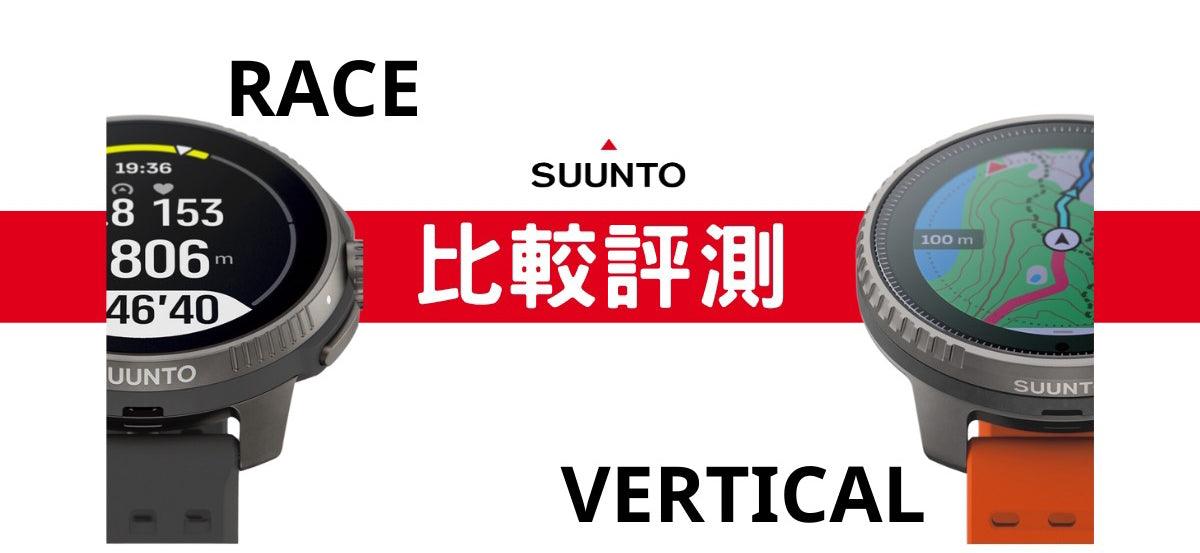Preface
Finnish sports watch brand Suunto launched the top outdoor watchVERTICAL and the high-performance cross-country running watch RACE , directly announcing Suunto's strong return to the public with new products. The two new products have different positionings in terms of appearance, function, and price. How can users who want to buy a new Suunto watch choose between the two?
Hardware Configuration
| VERTICAL | RACE | |
| 49mm | Body diameter | 49mm |
| 1.4” MIP touch screen | Screen | 1.43” AMOLED touch screen |
| 280x280px | resolution | 466x466px |
| sapphire crystal | Surface material | sapphire crystal |
| Grade 5 Titanium/Stainless Steel | Bezel material | Grade 5 Titanium/Stainless Steel |
| 74g (titanium)/86g (stainless steel) | weight | 69g (titanium)/83g (stainless steel) |
| 40 hours | Power (dual frequency positioning) | 60 hours |
| 12th | Daily power (all-weather optical heart rate) | 30th |
| Five-star dual-band | Satellite positioning | Five-star dual-band |
| 100 metres | water proof | 100 metres |
| 22mm | Strap width | 22mm |
| 3 buttons | Button settings | Rotating crown + 2 buttons |
Screen display comparison
VERTICAL and RACE have the same body diameter of 49mm, there is not much difference in screen size, and they are both touch screens. The most significant difference between the two is the display technology. RACE uses a 1000nits brightness AMOLED high-definition screen. AMOLED is a popular display technology for sports watches in recent years because it has bright and vivid colors like a mobile phone screen. Even during night activities, you can clearly see the screen display at a glance. Content .

Battery life comparison
Battery life is the biggest difference between VERTICAL and RACE . VERTICAL positioning is suitable for multi-day adventures in extreme environments . It has 60 hours of power when the high-efficiency mode of dual-frequency satellite positioning is turned on, and can be extended to a maximum of 120 hours of power when switching to a more power-saving mode. In addition, the VERTICAL titanium alloy version also has a solar charging function . When the surface is exposed to sunlight, the solar charging function will automatically activate, which can extend the battery life by up to 30%. The battery life is unmatched among other sports watches.

As for RACE, which is positioned as a cross-country running event, although its battery life is not as good asVERTICAL and it does not have solar charging function, RACE still has 40 hours of power in high-efficiency mode, which is basically enough to cope with 100 kilometers or even 100 miles of cross-country running events .
Therefore, when users are considering between VERTICAL and RACE , they can consider their own activity needs. In addition, even if you don’t need extreme environment adventure but often forget to charge your friends, you can also consider VERTICAL . Because VERTICAL has 30 days of daily use power (when 247 all-weather optical heart rate monitoring is turned on), even if you often forget to charge, it will be difficult for you to charge it. Drain its power.
Button design comparison
The button design seems to be a subtle part, but even though VERTICAL and RACE also have touch screen functions, buttons are still indispensable for most users to operate the watch. RACE has a rotating crown + 2 button design that has been adopted by many new watches in recent years, making the operation more intuitive and simple, and it will be easier for new users to get started.

As for VERTICAL's all-button design, I believe it is also designed for operation in extreme environment adventures. Overall, VERTICAL only has 3 buttons, so the operation is not complicated. However, it should be noted that unlike other sports watches, the "exit" operationof VERTICAL is not to press the lower button, but to press and hold the middle button . New users need to pay attention.
The above three parts are the main differences between VERTICAL and RACE. The following will also explain the common functions of VERTICAL and RACE, so that you can have a more comprehensive understanding of the two watches.
Heart rate monitoring
VERTICAL and RACE use the same optical heart rate sensor produced by LifeQ. In addition to supporting 24/7 heart rate monitoring, it also supports blood oxygen content ( SpO2 ) monitoring function . In addition, the sleep heart rate variability (HRV) function was added when RACE was launched, and now VERTICAL also supports this function after a firmware update.

The user wears the watch while sleeping and will get an HRV value when they wake up the next morning. When the user wears the watch while sleeping for 14 consecutive nights, the 7-day average HRV value will be obtained. In the future, the user can monitor their own HRV value based on this average value to understand the body's recovery status. Generally speaking, the higher the HRV value, it means that the body is in a state of lower physical and mental stress and better recovery.
Positioning navigation
VERTICAL and RACE are both "five-star dual-band" high-end configurations, supporting the world's five major satellite systems (GPS/GLONASS/Galileo/BDS/QZSS) and dual-band (L1+L5) satellite signals . Since both VERTICAL and RACE have excellent battery life, it is recommended that unless necessary, you only need to set the battery mode to "High Performance" and allow the watch to turn on the dual frequency for a long time to receive the strongest and most accurate satellite signals.

In addition to positioning, VERTICAL and RACE also support global offline maps. Users can download offline maps of the desired country or region in the Suunto App. The most important role of offline maps is to cooperate with the navigation function: users can design their own routes through Suunto App or download gpx files to enable the navigation function to ensure that the journey follows the correct route.
Summarize
AlthoughVERTICAL andRACE have some things in common, the two watches with different positioning still have their own characteristics. Users can choose the right watch according to their own needs.
VERTICAL has the best battery life in the market. With the solar charging function, it can maintain multi-satellite dual-frequency positioning for up to 85 hours. Users who have special requirements for power and who need to carry out multi-day adventures in extreme environments may consider it. choose.
As for the rising star RACE, it has a very high cost performance: a high-definition AMOLED screen and an easy-to-operate rotating crown button. The 40-hour multi-star dual-frequency positioning battery life is enough to cope with a 100-kilometer race. It is especially suitable for participating in cross-country events and even general running training. Home.
Suunto Race video review:
Suunto Vertical video review:


